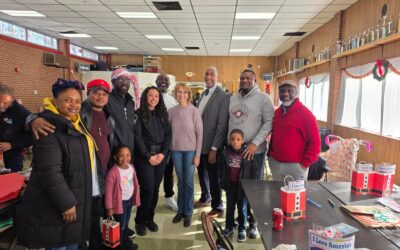Being a paper presented by Andrew Obinna Onyearu at Conference organised by the NASIC-United Kingdom and NAS, United Kingdom Chapter, at the Metropolitan University, London on Saturday, 20th November 2004.
Permit me to join the organisers of this conference in welcoming you to the NAS International Charity (NASIC) Conference on empowering the children of persons affected by leprosy in Nigeria.
The antecedents of this organisation will be more fully described to you by others particularly in relation to the circumstances that have brought about this conference but in summary, it is my responsibility to share with you, as briefly as I can, a number of critical facts about this organisation and the conference that we will all be participating in.
NAS considers itself a serious and responsible social organisation within and outside Nigeria. Over the years, it has embarked on a considerable amount of work within the Local and International Communities. Our organisation is one with strong advocacy objectives spanning various areas of societal life. In the event that you are coming across this organisation for the first time, I ask you to take sometime to familiarise yourself with the identity and antecedents of the organisation in respect of which you will find abundant information from the organisations web-site at www.nas-int.org Our historic and other information is set out with some abundance in the material on that web-site. NASIC is one of charity arms of the organisation. I am sure you will also permit me, very briefly, to talk about some of the work that this organisation is pursuing elsewhere in the following two years.
The organisation is involved in two legal initiatives namely, the Judicial Challenge Initiative (JCI) that represents the organisation entry into the area of strategic impact litigation. The organisation proposes to use litigation in asserting the rule of law to challenge circumstances about bad governance and social injustice including the circumstances that this conference will also discuss. The second legal initiative is a project called Legal Assistance and Prison Reform Initiative (LAPRI) by which the organisation, using the legal resources available to it, would provide legal assistance to individuals and disadvantaged persons, communities and groups and by so doing, assist in promoting legal and judicial reform in Nigeria. Again you can see the direct connection of this project to the subject that we shall be discussing in due course.
Of direct relevance to the question of empowerment is another programme that the organisation has called “Community Causes”. This is a programme designed to see the organisation act as the voice or mouthpiece for the underprivileged by the identification of serious infrastructural and other community defects; advocating the remedy for that community by identifying the appropriate public authorities and petitioning the authority on behalf of the community. Active consideration is now being given to the circumstances of the children of persons affected by leprosy with a view to articulating such a petition. The consequence will be to raise awareness by drawing attention to their circumstances and advocating, at the same time, for better living conditions. NAS is also implementing a very progressive “HIV/AIDS Advocacy” programme. The objective of this project is to develop an awareness programme that is designed to target behaviour formation in the young people between the ages 15 to 20. The intention of the programme is to ensure that young people develop contemporary patterns of behaviour receive positive influence by the kind of awareness of HIV/AIDS issues that translates into behavioural change. Again, the section of the community being discussed at this conference within that age bracket is instructive.
The purpose of this conference is to discuss the mechanics of empowering the children of persons affected by leprosy in Nigeria. I am sure that many of you are familiar with the condition, but I have found, myself, that to understand the peculiarities of the dependants of those living with leprosy, it is necessary to understand a little of what the condition is all about. The experts say that leprosy is an infectious disease caused by bacteria. It is also commonly understood that most people have a natural immunity to the disease and there are those that develop leprosy can be cured with multi drug therapy treatment (MDT). The information in the public domain about the effects of the condition is instructive. At The Leprosy Mission web site, the consequences of leprosy are encapsulated, concisely when it states that: –
…the leprosy germ affects nerves which lie near the skin, and, untreated, this can lead to a loss of feeling in the affected parts of the body. Most at risk are the hands, feet, and eyes/face. Because the person affected with the germ cannot feel, wounds or other injuries go unnoticed or untreated. Life-long care of anaesthetic limbs is one of the greatest challenges faced by people affected by leprosy, and neglect can cause damage so severe as to cause partial paralysis, such as clawed fingers… (an inability to blink, resulting in corneal ulcers and, if untreated, blindness).
People with leprosy in Nigeria face severe stigmatisation in the Nigerian society. Those cured experience stigmatisation because they continue to be confined to “leper colonies”. This is because their acceptance elsewhere is highly limited. In consequence, it has become necessary to consider ways to engender social and economic independence by giving them means to provide and manage for themselves. Those circumstances get worse. Their children, despite being free of the disease, bear the stigma of that affliction. They too are discriminated against by a society largely ignorant of the peculiarities of the condition and, in consequence, are forced to live with their parents. The result is that the education is stunted and opportunities limited. Their living conditions are often deplorable. Living quarters and other buildings that they occupy were built several years ago with little or no maintenance. Many have been driven to begging by dangerous and hazardous roadsides as means of obtaining money and food.
The response of the government has been, sadly slow. Healthcare measures full under the joint responsibility of the Federal Government, State Governments and Local Government Authorities. The Federal Government, through the Federal Ministry of Health plans and coordinates national health and care policies. The State Ministries are mainly responsible for the provision of healthcare and, at the same time, support the local structures managed by the Local Government Authorities. We are told that the Federal Ministry of Health in Nigeria has formulated a national health plan for the period between 1998 and 2010. In this plan, they offer to put a Primary Healthcare (PHT) approach designates leprosy and tuberculosis as priority areas. To combat leprosy and TB and tuberculosis, Federal Government have indicated that it has developed a National Tuberculosis and Leprosy Control Programme (NTBLCP) that is led by a central unit. The NTBLCP has drawn up to a three-year plan for combating leprosy and a five-year plan for tuberculosis. Central to both plans is a need to integrate TBL treatment into general healthcare. Integration is considered to be the most important strategy to ensure sustainability, accessibility and effectiveness of the TBL programme. We are informed that a start has been made in this respect although the provisions in relation to support for the dependents is, itself, very thin.
NAS believes that the amelioration of the condition of both those afflicted with leprosy and their dependants must target empowerment as a key initiative. There is a need not only to supplement the medical treatment but also to provide support to the structures present amongst those living with leprosy. Their living accommodations must be improved upon. Educational facilities must be provided and, where existing in skeletal form, substantially improved. Means must be sought by which those with the condition can be integrated into their communities as self-supporting individuals without the shackles of discrimination. Their independence must be empowered with education, a fundamental tool in the appreciation of as well as eradication of discriminatory practices. This approach is at the very root of the information technology and computer literacy element of the Skill Acquisition Programme that is being pursued by NASIC in the leprosaria with which it is involved.
Leprosy is a disease of poverty. The prevalence rate in Nigeria, we understand, is approximately 5.2 in 100.000 people. The stark lack of resources inhibits the ability to combat the disease and all its ancillary consequences. The result is that both those with the condition and their dependents are adversely affected. NAS, in its own small way, is pursuing its projects to assist but, equally importantly, to enlist International Assistance and Support, this representing the principal means by which the disease and its consequences can be effectively combated. In an environment of competing interests, but, we continue to be told by government, insufficient resources to meet all needs, the small voice and momentum we are, by mediums such as this, able to generate, can only bring about better living conditions for those with the misfortune of having to deal with such a debilitating condition.
We thank you for your support, encouragement and assistance and most of all, belief in the necessity to advocate the entitlements of those afflicted and affected with leprosy, to a better life.
ANDREW OBINNA ONYEARU
NAS CAPON



